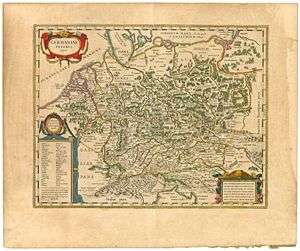Germania (book)

The Germania, written by the Roman historian Publius Cornelius Tacitus around 98 AD and originally entitled On the Origin and Situation of the Germanic Peoples (Latin: De Origine et situ Germanorum), was a historical and ethnographic work on the Germanic tribes outside the Roman Empire.
Contents
The Germania begins with a description of the lands, laws, and customs of the Germanic people (Chapters 1–27); it then describes individual tribes, beginning with those dwelling closest to Roman lands and ending on the uttermost shores of the Baltic, among the amber-gathering Aesti, the Fenni, and the unknown tribes beyond them.
Tacitus says (Ch. 2) that physically, the Germanic peoples appear to be a distinct nation, not an admixture of their neighbors, as nobody would desire to migrate to a climate as horrid as that of Germania. They are divided into three large branches, the Ingaevones, the Herminones and the Istaevones, deriving their ancestry from three sons of Mannus, son of Tuisto, their common forefather. In Chapter 4, he mentions that they all have common physical characteristics, blue eyes (truces et caerulei oculi = "sky-coloured, azure, dark blue, dark green), reddish hair ( rutilae comae = "red, golden-red, reddish yellow") and large bodies, vigorous at the first onset but not tolerant of exhausting labour, tolerant of hunger and cold but not of heat.[1]
In Chapter 7, Tacitus describes their government and leadership as somewhat merit-based and egalitarian, with leadership by example rather than authority and that punishments are carried out by the priests. He mentions (Ch. 8) that the opinions of women are given respect. In Chapter 9, Tacitus describes a form of folk assembly rather similar to the public Things recorded in later Germanic sources: in these public deliberations, the final decision rests with the men of the tribe as a whole.
Tacitus further discusses the role of women in Chapters 7 and 8, mentioning that they often accompany the men to battle and offer encouragement. He says that the men are often highly motivated to fight for the women because of an extreme fear of losing them to captivity. Tacitus says (Ch. 18) that the Germans are mainly content with one wife, except for a few political marriages, and specifically and explicitly compares this practice favorably to other barbarian cultures, perhaps since monogamy was a shared value between Roman and Germanic cultures. He also records (Ch. 19) that adultery is very rare, and that an adulterous woman is shunned afterward by the community regardless of her beauty. In Chapter 45 Tacitus mentions that the tribe to the north of the Germans, the Sitones, "resemble [the Suevi Scandinavians] in all respects but one - woman is the ruling sex."[2]
The latter chapters of the books describe the various Germanic tribes, their relative locations and some of their characteristics. Many of the tribes named correspond with other (and later) historical records and traditions, while the fate of others is less clear.
Purpose and sources
Ethnography had a long and distinguished heritage in classical literature, and the Germania fits squarely within the tradition established by authors from Herodotus to Julius Caesar. Tacitus himself had already written a similar—albeit shorter—essay on the lands and tribes of Britannia in his Agricola (chapters 10–13). The work can appear moralizing at points, perhaps implicitly comparing the values of Germanic tribes and those of his Roman contemporaries, although a direct comparison between Rome and Germania is not explicitly presented in the text. In writing the work, Tacitus might have wanted to stress the dangers that the Germanic tribes posed to the Empire.
Tacitus' descriptions of the Germanic character are at times favorable in contrast to the opinions of the Romans of his day. He holds the strict monogamy and chastity of Germanic marriage customs worthy of the highest praise, in contrast to what he saw as the vice and immorality rampant in Roman society of his day (ch. 18), and he admires their open hospitality, their simplicity, and their bravery in battle. All of these traits were highlighted perhaps because of their similarity to idealized Roman virtues. One should not, however, think that Tacitus' portrayal of Germanic customs is entirely favorable; he notes a tendency in the Germanic people for what he saw as their habitual drunkenness, laziness, and barbarism, among other traits.
The ethnonym Germani as used by Tacitus does not necessarily coincide with the modern linguistic definition of Germanic peoples as any people speaking a Germanic language, and the details of the classification Germani have been debated in scholarship, e.g. the possibility that the Batavians may therefore have been Celtic-speaking. Tacitus nevertheless shows no lack of precision in stating that the Nervii are not actually Germanic as they claim to be. (Ch. 28) He also notes in Chapter 43 that a certain tribe called the Cotini actually speaks a Gallic tongue, and likewise the Osi speak a Pannonian dialect.
Tacitus himself had never travelled in the Germanic lands; all his information is second-hand at best.[3] Ronald Syme supposed that Tacitus closely copied the lost Bella Germaniae of Pliny the Elder, since the Germania is in some places outdated: in its description of the Danubian tribes, says Syme, "they are loyal clients of the Empire ... Which is peculiar. The defection of these peoples in the year 89 during Domitian's war against the Dacians modified the whole frontier policy of the Empire." (p. 128). While Pliny may have been the primary source, scholars have identified others; among them are Caesar's Gallic Wars, Strabo, Diodorus Siculus, Posidonius, Aufidius Bassus, and numerous non-literary sources: presumably based on interviews with traders and soldiers who had ventured beyond the Rhine and Danube borders, and Germanic mercenaries in Rome.

Reception
All copies of Germania were lost during the Middle Ages and the work was forgotten until a single manuscript was found in Hersfeld Abbey (Codex Hersfeldensis) in 1425. It was then brought to Italy, where Enea Silvio Piccolomini, later Pope Pius II, first examined and analyzed the book. This sparked interest among German humanists, including Conrad Celtes, Johannes Aventinus, and Ulrich von Hutten and beyond.
The peoples of medieval Germany (the Kingdom of Germany in the Holy Roman Empire) were heterogenous, separated in distinct tribal kingdoms, such as the Bavarians, Franconians, and Swaibians, distinctions which remain evident in the German language and culture after the unification of Germany in 1871 and the establishment of modern Austria and Germany. During the medieval period a self-designation of "Germani" was virtually never used, the name was only revived in 1471, inspired by the rediscovered text of Germania, to invoke the warlike qualities of the ancient Germans in a crusade against the Turks. Ever since its discovery, treatment of the text regarding the culture of the early Germanic peoples in ancient Germany remains strong especially in German history, philology, and ethnology studies, and to a lesser degree in Scandinavian countries as well. Beginning in 16th-century German humanism, German interest in Germanic antiquity remained acute throughout the period of Romanticism and nationalism. A scientific angle was introduced with the development of Germanic philology by Jacob Grimm. Because of its influence on the ideologies of Pan-Germanism and Nordicism, Jewish-Italian historian Arnaldo Momigliano in 1956 described Germania as "among the most dangerous books ever written".[4] Christopher Krebs, a professor at Stanford University, claims in a 2012 study that Germania played a major role in the formation of the core concepts of Nazi ideology.[5] The mainstream German reception is much less alarmist and sees Tacitus's description as more patronizing than laudatory, a predecessor of the classical noble savage concept which started in the 17th and 18th century in western respectively European literature.[6] Krebs has been criticized harshly for leaving out anything "not leading to Himmler" and especially leaving out the important influence of Tacitus Germania on e.g. Scandinavism or Abbé Sieyès notion of the third estates nor the rather different interpretation between fascist allies Germany and Italy.[7]
Codex Aesinas
The Codex Aesinas is believed to be portions of the Codex Hersfeldensis - the lost Germania manuscript brought to Rome from Hersfeld Abbey. It was rediscovered in 1902 by priest-philologist Cesare Annibaldi in the possession of Count Aurelio Balleani of Iesi.[8]
Hitler and Himmler sought unsuccessfully to gain possession of the Codex Aesinas.
Temporarily transferred to Florence for the controls at the state body of the fine arts, the manuscript was severely damaged during the 1966 flood. It was later restored and brought back to Iesi, and in 1994 the Codex Aesinas was given to the National Library in Rome, catalogued as Cod. Vitt. Em. 1631.[9]
Editions and translations
- Church, Alfred John and Brodribb, William Jackson (trans.), 1877.
- Furneaux, Henry (ed.), 1900.
- Gordon, Thomas. (trans.), 1910.
- Anderson, J.G.C. (ed.) (1938). Germania. Oxford: Clarendon Press.
- Syme, Ronald. (ed.), Tacitus, vol. 1 Oxford: Clarendon Press, 1958
- Önnerfors, Alf. (ed.) De origine et situ Germanorum liber. Teubner, Stuttgart: 1983, ISBN 3-519-01838-1 (P. Cornelii Taciti libri qui supersunt, T. 2,2)
- Rives, J. B. (trans.) Tacitus: Germania. Oxford: 1999
See also
- Ancient Germanic peoples
- Germanic paganism
- Germanic peoples
- Noble savage
- Regnator omnium deus
- literary forgery
- false document
References
Notes
- ↑ unde habitus quoque corporum, tamquam in tanto hominum numero, idem omnibus: truces et caerulei oculi, rutilae comae, magna corpora et tantum ad impetum valida. [3] laboris atque operum non eadem patientia, minimeque sitim aestumque tolerare, frigora atque inediam caelo solove adsueverunt.
- ↑ http://www.unrv.com/tacitus/tacitus-germania-12.php
- ↑ Alfred Gudeman (1900). "The Sources of the Germania of Tacitus". Transactions and Proceedings of the American Philological Association. The Johns Hopkins University Press. 31: 93–111. doi:10.2307/282642. JSTOR 282642.
- ↑ Anthony Birley, ‘Introduction’, in Tacitus, Agricola and Germany (Oxford University Press, 1999), p. xxxviii.
- ↑ Christopher B. Krebs, A Most Dangerous Book: Tacitus’s Germania from the Roman Empire to the Third Reich (New York: W.W. Norton, 2012), p. 22.
- ↑ Paradies auf Erden?: Mythenbildung als Form von Fremdwahrnehmung : der Südsee-Mythos in Schlüsselphasen der deutschen Literatur Anja Hall Königshausen & Neumann, 2008
- ↑ Frankfurter Allgemeine Zeitung, 10.03.2012, S. L19 Krebs, Christopher B.: Ein gefährliches Buch - Die "Germania" des Tacitus und die Erfindung der Deutschen. ISBN 978-3-421-04211-8 Zu kurz gesprungen: Der Harvard-Philologe Christopher B. Krebs verfolgt die Rezeptionslinie der "Gemania" vonTacitus - und endet bei Himmler. Lorenz Jäger, FAZ review
- ↑ Hamilton, Andrew Tacitus’ Germania
- ↑ Codex Aesinas at the National Library in Rome
Bibliography
- Dorey, T. A., 'Agricola' and 'Germania', in Tacitus (London, Routledge and Kegan Paul, 1969) (Studies in Latin Literature series)
- Gudeman, Alfred, The Sources of the Germania of Tacitus, in Transactions and Proceedings of the American Philological Association, Vol. 31. (1900), pp. 93–111
- Christopher B. Krebs, Negotiatio Germaniae. Tacitus' Germania und Enea Silvio Piccolomini, Giannantonio Campano, Conrad Celtis und Heinrich Bebel (Göttingen: Vandenhoeck & Ruprecht, 2005). ISBN 3-525-25257-9.
- Christopher B. Krebs, A Most Dangerous Book: Tacitus’s Germania from the Roman Empire to the Third Reich (New York: W.W. Norton, 2012). ISBN 978-0-393-06265-6.
- Schama, Simon, 1995. Landscape and Memory 2.i "The hunt for Germania"
Further reading
- Robinson, Rodney Potter (1935). The Germania of Tacitus (Middletown, Connecticut; American Philological Association) (textual and manuscript analysis)
- Schellhase, Kenneth C. (1976). Tacitus in Renaissance Political Thought (Chicago)
External links
| Wikisource has original text related to this article: |
| Wikiquote has quotations related to: Tacitus |
- Thomas Gordon's 1737 translation (Reprinted 1910, 1910)
- Alfred John Church and William Jackson Brodribb's translations (1868, 1868; revised 1876, reprinted 1899, 1942)
- Edward Brooks's translation (1897)
- Lamberto Bozzi's translation (2012)
- Roger Pearse's "Tacitus and his manuscripts"
-
 Germania public domain audiobook at LibriVox
Germania public domain audiobook at LibriVox
